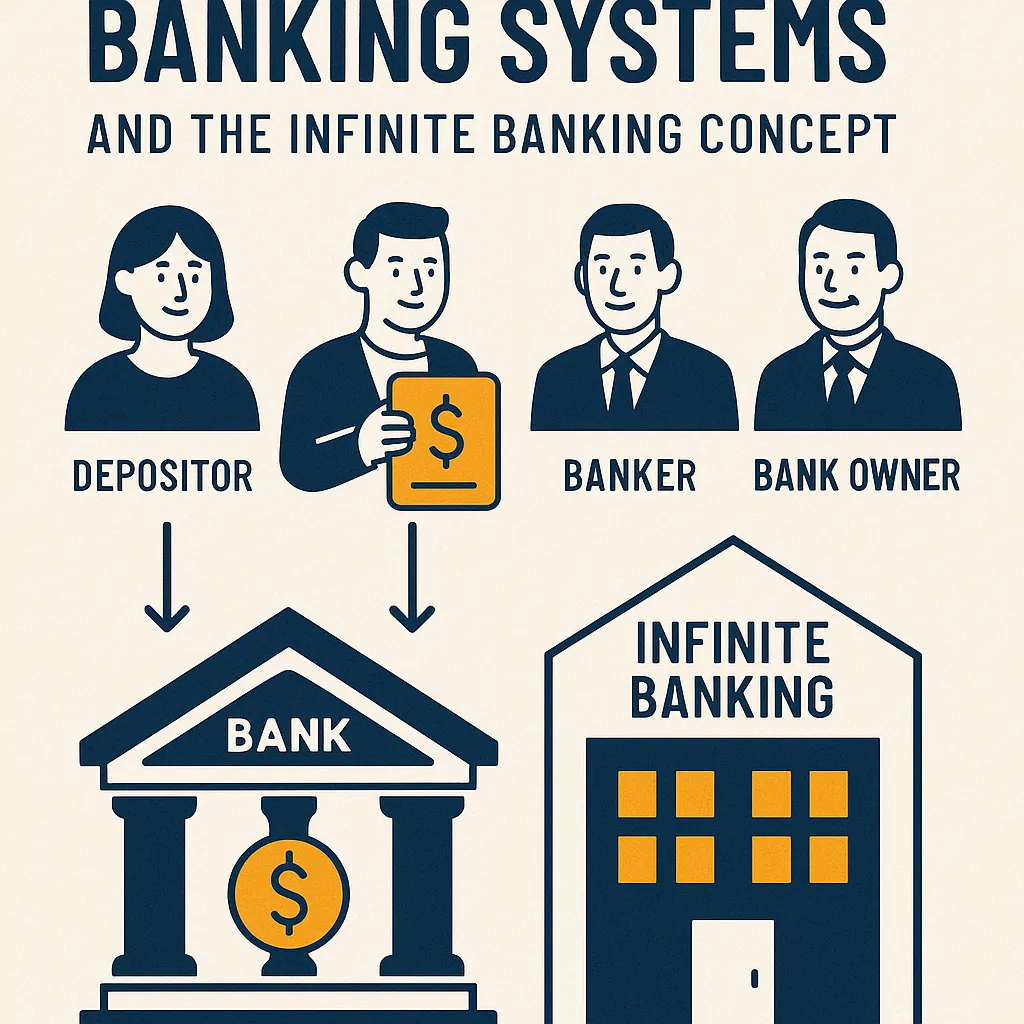
Understanding Banking Systems and the Infinite Banking Concept
Understanding Banking Systems and the Infinite Banking Concept
Banking is the most fundamental business in the world. Without it, no other business could function. And here’s the truth: you’re already in the banking business — you’re just not the one profiting from it.
To understand the Infinite Banking Concept (IBC), you first need to understand how traditional banking systems work and where banks make their profits.
The Four Characters of Banking
A banking system always has four key players:
The Depositor – the person who puts money into the bank.
The Borrower – the person who takes out loans.
The Banker – the one who decides who qualifies, under what conditions, and at what interest rate.
The Bank Owner – the one who ultimately collects the profits from the system.
Imagine a bank as a house: the front door is where depositors walk in and hand over their money. The back door is where borrowers line up to take loans. Inside, the banker manages the process, and upstairs, the owner sits back and enjoys the profits.
How Banks Really Work
At the front door, depositors hand over their money, often putting it in a savings account. The bank may even pay a little interest to make it attractive. On the surface, it looks like you’re getting a good deal — your money is safe and might even grow a bit.
But step around to the back door and you’ll see what’s really happening. A borrower comes in asking for a loan. The banker reviews their credit history, sets terms, and approves the loan.
Here’s the billion-dollar question: where does that loan money come from?
It doesn’t come from the bank’s own pocket. It comes from the money deposited at the front door — your money.
The bank then charges the borrower interest. That interest is the bank’s profit.
Depositors provide the capital.
Borrowers take out loans.
Bankers set the terms.
Bank owners pocket the profits.
That’s the business of banking in a nutshell.
The Problem for Everyday People
Most of us only ever play two roles: depositor and borrower.
That means your savings are being lent out — sometimes even back to you in the form of a mortgage, car loan, or line of credit — and the bank is profiting off the spread. In other words, you’re funding the bank’s profits with your own money.
Enter the Infinite Banking Concept
The Infinite Banking Concept flips this around. With a specially designed Participating Whole Life Insurance Policy, you can take on all four roles in the banking system.
Depositor: Your premiums fund the system. These deposits (premiums) grow and compound uninterrupted for as long as you own the policy.
Borrower: Instead of withdrawing money, you borrow against the cash value of your policy through a policy loan. Your money keeps compounding while you access capital.
Banker: You set the terms of your own loan. You decide if you qualify, what your repayment schedule looks like, and how aggressively you want to pay it back.
Bank Owner: As a policyholder, you’re also a part owner of the insurance company. Each year, the insurer shares profits with policyholders in the form of dividends. A portion of those profits comes from interest charged on policy loans — including yours.
Why Policy Loans Are Different
When you take a loan from your policy, it’s secured by your death benefit. That’s why the insurance company doesn’t need to impose the same hoops and hurdles as a bank.
If you repay it, great — you restore your full borrowing capacity.
If you don’t, the loan balance is simply deducted from your death benefit before it’s paid to your beneficiaries.
But there’s a catch: if you ignore repayments completely, the compounding loan interest will eventually reduce your ability to borrow. That’s why, when you act as your own banker, it’s smart to create a repayment plan and even “charge yourself” a higher interest rate. Every dollar repaid goes back into your system, strengthening it.
The Role of Dividends
Here’s the part most people miss: with a participating whole life policy, you also share in the profits of the insurance company. Once a year, they distribute a divisible surplus to all policyholders. Part of that surplus comes from interest earned on policy loans.
That means even when you borrow, you’re indirectly recapturing a portion of the interest you paid. In other words, you’re not just the depositor, borrower, and banker — you’re the owner too.
Taking Back Control
Banking is unavoidable. You either use the traditional system and fund the profits of big banks, or you take back control of the banking function in your own life.
With the Infinite Banking Concept, you’re no longer stuck as just depositor and borrower. You become all four characters — and you keep the profits in your system instead of handing them away.
This shift doesn’t just change your finances today. It creates long-term financial freedom, stability, and the potential for generational wealth.